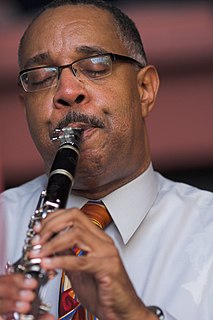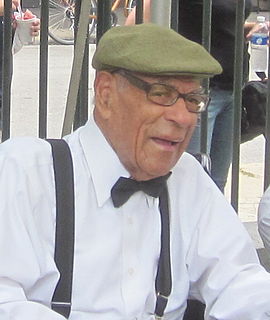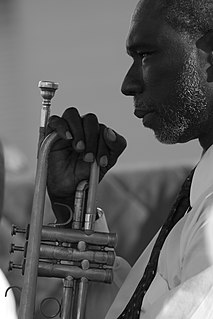
Charles Joseph "Buddy" Bolden was an African American cornetist who was regarded by contemporaries as a key figure in the development of a New Orleans style of ragtime music, or "jass", which later came to be known as jazz.

The Reverend is an honorific style most often placed before the names of Christian clergy and ministers. There are sometimes differences in the way the style is used in different countries and church traditions. The Reverend is correctly called a style but is often and in some dictionaries called a title, form of address, or title of respect. The style is also sometimes used by leaders in non-Christian religions such as Judaism and Buddhism.

Kermit Ruffins is an American jazz trumpeter, singer, composer, and actor from New Orleans. He has been influenced by Louis Armstrong and Louis Jordan and says that the highest note he can hit on trumpet is a high C. He often accompanies his songs with his own vocals. Most of his bands perform New Orleans jazz standards though he also composes many of his own pieces. Jon Pareles of The New York Times wrote, "Mr. Ruffins is an unabashed entertainer who plays trumpet with a bright, silvery tone, sings with off-the-cuff charm and never gets too abstruse in his material."

Michael White is a jazz clarinetist, bandleader, composer, jazz historian and musical educator. Jazz critic Scott Yanow said in a review that White "displays the feel and spirit of the best New Orleans clarinetists".

The Rebirth Brass Band is a New Orleans brass band. The group was founded in 1983 by Phillip "Tuba Phil" Frazier, his brother Keith Frazier, Kermit Ruffins, and classmates from Joseph S. Clark Senior High School, which closed in the spring of 2018, in the Tremé neighborhood of New Orleans. Arhoolie released its first album in 1984.

A jazz funeral is a funeral procession accompanied by a brass band, in the tradition of New Orleans, Louisiana.

The Dirty Dozen Brass Band is a brass band based in New Orleans, Louisiana. The ensemble was established in 1977, by Benny Jones and members of the Tornado Brass Band. The Dirty Dozen revolutionized the New Orleans brass band style by incorporating funk and bebop into the traditional New Orleans jazz style, and since has been a major influence on local music.
The Hurricane Brass Band was a brass band from New Orleans, Louisiana. Established by Leroy Jones in 1974 when the Fairview Baptist Church Marching Band was disbanded, the group included Jones and Gregory Davis on trumpet, Darryl Adams on alto saxophone, and Anthony "Tuba Fats" Lacen on sousaphone. When Jones left the band to pursue a solo career, Adams took over as leader and renamed the group the Tornado Brass Band. Adams still serves as the leader of Tornado Brass Band. While some members of the band went on to form the Dirty Dozen Brass Band in 1977.

Leroy Jones is a jazz trumpeter. Born in New Orleans, Louisiana, Jones began playing trumpet at the age of ten, and by the time he was 12 was leading the Fairview Baptist Church Marching Band, a group of young musicians organized by jazz guitarist and banjo player Danny Barker. When the musicians' union forced Barker to disband the group in 1974, Jones became a union musician and took over the running of the group, renamed the Hurricane Brass Band, himself. In 1975 or 1976, he left the group, touring for a time with Eddie Vinson and Della Reese before forming his own group, the Leroy Jones Quintet. In 1991, Jones joined the big band of Harry Connick, Jr., and the exposure with Connick's band, led to Jones' releasing his first album under his own name; Mo' Cream From The Crop came out on the Columbia label in 1994. The Leroy Jones Quintet continues to tour and record, and since 2004 Jones has also appeared with the Preservation Hall Jazz Band and Dr. John.

Daniel Moses Barker was an American jazz musician, vocalist, and author from New Orleans. He was a rhythm guitarist for Cab Calloway, Lucky Millinder and Benny Carter during the 1930s.

Germantown Baptist Church dates back to 1838 in Germantown, Tennessee and is a large Southern Baptist church, formerly categorized as a megachurch. The church is 179 years old, and since its founding has moved from its location in downtown Germantown to an over 300,000-square-foot (28,000 m2) building complex on a 64-acre (260,000 m2) campus near the border of Germantown and Collierville on Poplar Avenue. As of October 2009, the church has an average Sunday worship attendance of 2,064 and an annual budget of $7,564,896. The original building for the church still stands on Germantown Road. Built twenty-one years before the beginning of the Civil War, Germantown Baptist Church is the second oldest church in the city of Germantown.
Morgan Edwards was an American historian of religion, Baptist pastor, notable for his teaching on the 'rapture' before its popularization by John Nelson Darby (1800–1882).

Lionel Charles Ferbos was an American jazz trumpeter. He was from New Orleans, Louisiana.
Paul Sylvester Morton is an American Baptist pastor. He is the senior pastor of Changing a Generation Full Gospel Baptist Church in Atlanta, Georgia, and co-pastor of Greater St. Stephen Full Gospel Baptist Church in New Orleans, Louisiana. He is also a recording artist, author, and founder of the Full Gospel Baptist Church Fellowship, International.

Ernest "Doc" Paulin was a New Orleans jazz brass band leader and trumpeter.
The Onward Brass Band was either of two brass bands active in New Orleans for extended periods of time.

Tradition Is a Temple is an American documentary film about New Orleans jazz culture and modernization's effect on American traditions, written and directed by Darren Hoffman and released in 2013.

Shannon Powell is an American jazz and ragtime drummer. He has toured internationally and played with Ellis Marsalis, Harry Connick, Jr., Danny Barker, Branford Marsalis, Wynton Marsalis and the Lincoln Center Jazz Orchestra, Diana Krall, Earl King, Dr. John, Marcus Roberts, John Scofield, Jason Marsalis, Leroy Jones, Nicholas Payton, and Donald Harrison Jr. Powell toured and recorded with fellow New Orleans native, Harry Connick Jr.

Gregory Vaughan "Gregg" Stafford is an American jazz cornetist and trumpeter. He has been a jazz music educator in New Orleans since the 1980s and has led the Young Tuxedo Brass Band for more than thirty years.

Dave Albert Williams Jr. was an American jazz, blues, and rhythm & blues pianist, bandleader, singer, and songwriter. He was the author of "I Ate Up The Apple Tree", a staple of contemporary New Orleans brass bands. His career as a working musician spanned five decades.
















